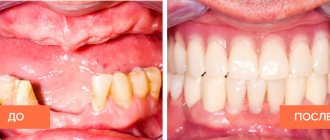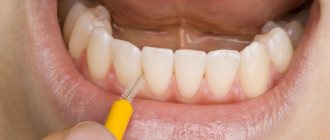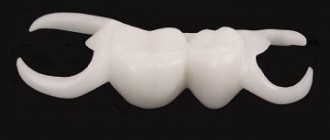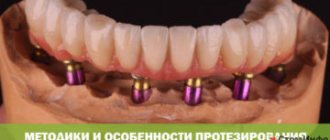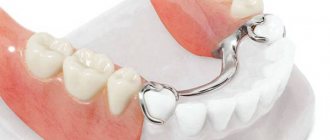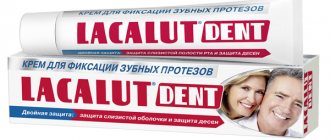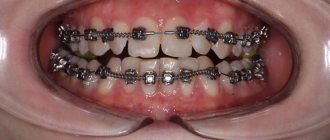1683
Telescopic prosthetics is a practical and one of the best ways to restore dentition.
The design is named because the structure resembles a spyglass. Prostheses are easy to use and can be easily repaired if they break.
Thanks to modern technologies, it is possible to restore a significant number of lost units.
How does a prosthesis work?
Removable dentures on telescopic crowns consist of two parts:
Photo: prosthesis on telescopic crowns
- Fixed part of the structure. This is a cap made of metal, which is firmly attached to the abutment tooth. Outwardly it looks like a thimble. Attached to the abutment tooth using cement or an implant.
- The removable part of the structure is the prosthesis itself. This can be a clasp or bridge prosthesis. A metal-ceramic crown is firmly mounted into it.
When putting the removable part on the non-removable part, a strong and reliable fixation of the prosthesis occurs.
The modern telescopic design allows the removable part of the denture to be securely attached to the supporting teeth, and if necessary, the denture can be easily removed.
There are two types of crowns for telescopic fixation of the prosthesis:
- Conical.
- Cylindrical.
Conical bits are less sensitive to manufacturing errors and wear.
Photo: conical telescopic crowns
The more pronounced the taper of the crowns, the less effort is required to separate them. Conical crowns are not capable of
jamming and distortion. The downside of having a weak grip can be that they can easily come loose from sticky food or tongue.
The use of conical crowns is indicated in all cases of removable dentures.
Cylindrical crowns have parallel walls that slide against each other and have difficulty providing traction. They are used only on teeth with intact periodontium.
Due to the complexity of manufacturing, such designs are used very rarely.
System structure
Telescopic dentures are removable types of systems. They consist of several elements:
- The non-removable part is a cap fixed to the abutment tooth using special dental cement. It is made from various metal alloys.
- The prosthesis itself , which can be either a bridge or a clasp. It is on this that the metal-ceramic crown is fixed.
Telescopic prosthetics allows you to restore from one to several units in the presence of supporting elements. The structure is fixed like a telescope, when the individual parts are put on each other.
Thus, a reliable fixation is obtained. If necessary, the prosthesis can be easily removed and put on again.
Materials for dentures on telescopic crowns
Removable dentures with a telescopic fixation system are made from special dental alloys.
- The removable and non-removable parts of the structure are made of the same alloy, if possible.
- The alloys used to make prostheses are hypoallergenic and safe for health. They do not oxidize in the oral cavity.
- An alternative to gold crowns are alloys of base metals. When making a prosthesis from gold, the design is more accurate, but at the same time, more expensive.
- A more rational solution in technical terms is galvanic technology. Thus, the main part can be made of zirconium dioxide or an alloy of base metals, and the outer part can be made of gold. This method is high-tech.
How it works
- First, the remaining natural teeth are ground down. If there are enough of them for good fixation, then healthy teeth become part of the prosthesis; if there are complete absence of teeth, several artificial ones are implanted into the alveolar bone of the jaw.
- After grinding, the teeth are covered with permanent crowns using a special cementing solution. These are called the “primary parts” of telescopic crowns. Crowns can be made from various metals or zirconium oxide.
- Next, a removable denture is created in a dental laboratory (without a palatal plate - if it is the upper jaw, or without a hyoid arch - if it is the lower jaw), on which the “secondary parts” of the telescopic crowns are also firmly fixed. Most often, the base for them is metal, and the lining is acrylic with ceramic filler.
- Then the removable (clasp) denture is put on the teeth by combining two crowns: the secondary crown “sits” on the primary one. This ensures fixation of the prosthesis in the oral cavity.
Pros and cons of telescopic dentures
Advantages of dentures on telescopic crowns:
- The interdental spaces are quite accessible when the prosthesis is removed, which makes it possible to provide complete hygienic dental care.
- With further loss of teeth, the structure can be converted.
- Holds securely in the mouth.
- High aesthetics. The prosthesis is invisible to others.
- Structural strength.
- Chewing pressure is distributed to the supporting teeth, which has a beneficial effect on the periodontium.
- Does not affect diction.
Disadvantages of telescopic dental structures:
- Need for large space due to double dental crowns.
- Very expensive.
Advantages and disadvantages
Experts note the following characteristics as advantages of products:
- do not affect pronunciation;
- short adaptation period;
- There are two installation options - on the remaining teeth-supports or implants;
- are wear resistant and durable;
- fit securely in the mouth;
- not visible to others;
- do not cover the salivary glands, which means the mucous membrane will not dry out;
- easy care and long period of operation;
- due to the absence of the palatal element, a person does not experience discomfort, the manifestation of a gag reflex is excluded, and the taste perception of food does not change;
- in case of loss of another “native” tooth, the device can be remade and adjusted to the new condition of the oral cavity;
- the load during chewing is distributed evenly, which has a beneficial effect on the periodontal tissues.
Such products are not without their drawbacks. Compared to the large list of advantages, there are much fewer of them:
- the fastening weakens over time, so the structure must be adjusted every 3 years;
- installation requires more space between dental elements than when placing classic crowns;
- the technique is not a gentle technology, since it involves grinding the teeth;
- production takes a long time, and you have to come back several times to try on the design;
- high price.
Prices for telescopic dentures
The cost of telescopic dentures depends on the material from which the teeth are made, as well as on the number of teeth on which the structure will be fixed. The high cost of the design is explained by the fact that two crowns are made for each tooth.
Cost of telescopic removable dentures:
| Type of prosthesis | Price, rub.) |
| Telescopic crown, (1 unit) | 21000 |
| Clasp telescopic prosthesis, (1 unit) | 22000 |
Operational period
Prostheses can be successfully used for ten years. Over time, the devices will become less durable and looser.
Telescopic dentures can be successfully used for ten years
To ensure a long period of use, it is necessary to correctly follow all recommendations for care and use, undergo regular examinations by a dentist and make timely corrections.
How to care:
- The device can be used twenty-four hours a day;
- the structure is removed for hygienic treatment;
- there is no need to leave the device in a container with liquid while sleeping;
- the device should be removed in front of a sink and a soft cloth;
- manipulations of taking off and putting on should be carried out in front of a mirror;
- You should regularly bring your prosthesis for examination to monitor its functionality.
Care
Rules for caring for removable dentures with telescopic crowns:
- The structure can be used around the clock.
- The prosthesis needs to be removed only for hygienic treatment.
- There is no need to place the structure in a glass of water overnight.
- Removal and installation of the prosthesis must be carried out in front of the sink, placing a soft towel in it. To prevent damage to the prosthesis if it falls.
- It is necessary to remove and put on the structure in front of a mirror.
- It is necessary to undergo a medical examination, because... This type of prosthesis requires control of the structure’s functions by a specialist.
Service life and care rules
The minimum service life of a telescopic prosthesis is 3 years. With proper care, the structure can last longer - up to 10 years. Like all dentures, over time they become less secure and require correction. To maximize the life of the structure, it is recommended to regularly visit the dentist and properly care for the prosthesis.
Telescopic dentures are designed to be worn around the clock - there is no need to put them in water before going to bed. The structure will only need to be removed for hygienic cleaning. Care activities include:
- cleaning dentures after eating (it is advisable to use special brushes for dentures with long bristles and a wide head;
- use of tablets to clean dentures (in consultation with the dentist);
- prof. examinations by a doctor to check the condition of the prosthesis.
To avoid damaging the structure during home cleaning, it is best to remove and put on the prosthesis in front of a mirror over a soft surface or over a sink with water or a towel (if the prosthesis slips out of your hands, it will not be damaged).
Alternatives
Choosing a prosthetic method is always a difficult task for the patient. Therefore, the patient should be aware of alternative types of dental prosthetics.
- Dental implantation. An excellent alternative to any type of removable prosthetics. Photo: Clasp prosthesis on telescopic crowns
- Removable structures are inferior to prostheses on telescopic crowns in terms of fixation methods and comfortable use. Sometimes tooth extraction is required to install removable dentures.
- Nylon dental structures are inferior to prostheses on telescopic crowns in terms of use. If a tooth is lost under the structure, it is not possible to repair nylon dentures.
- Clasp dental structures with micro-locks are a good alternative to telescopic removable dentures. But they cannot be made if the patient has a small number of teeth.
Minuses
Before undergoing the procedure, the patient must consider all the pros and cons and decide what suits him best, naturally with the doctor’s recommendation:
- if a person initially had a metal crown installed, sometimes it is visible in the supragingival part. It is recommended to use a special cap in a visible place to cover the defect;
- Many people do not like the technique because it requires grinding of teeth, which is why it is considered not gentle;
- every day a person must clean the structure to prevent caries, remove plaque and food particles;
- if the device is made using implants, then in the event of a breakdown it is necessary to completely redo the entire system;
- for installation you need to visit a specialist many times and take measurements;
- The technique costs a lot of money if you compare it with others.
Telescopic dentures cost a lot of money compared to others - this is one of the disadvantages of this method of prosthetics.
However, the price is justified by the period of operation, external data, practicality, and a good price for repair work.
Reviews
- I have been fitted with clasp dentures on telescopic crowns. I'm very pleased with them. They are not visible to others, and I got used to them very quickly. (Irina Petrovna, Voronezh)
- I wore an acrylic prosthesis for three years - it was terribly uncomfortable, especially while eating. With a telescopic prosthesis I feel young and confident! I even forget about its existence. (Olga Vladimirovna, Moscow)
- Finally I have the opportunity to smile! I am very pleased with the prosthesis with telescopic crowns, although it took me a while to get used to it. (Ivan Dmitrievich, Krasnoyarsk)
- I thought that the process of installing a telescopic removable denture would take a very long time. It turned out that this is not so. The work was done very quickly. Very pleased with the dental design. (Boris Petrovich, Perm)
Installation
Before proceeding with prosthetics, the dentist must examine and diagnose the condition of the oral cavity and dental units, eliminate possible contraindications and draw up a treatment and restoration plan.
Prosthetics using attachments on telescopic crowns are carried out according to the following algorithm:
- Treatment of teeth and mucous membranes (elimination of relative contraindications).
- Extraction of “dead” teeth.
- Grinding of supporting units.
- Taking impressions of the jaws and sending them to the dental technician in the laboratory.
- Creation of a plaster model of the jaw.
- Manufacturing of a prosthetic structure that will temporarily replace lost units and protect prepared crowns.
- Trying on a prosthesis.
After this, a permanent device is created, which the orthodontist fixes in the mouth and explains to the patient how to use it and how to care for it.
Care
The average service life of a telescopic prosthesis is 5-7 years, but with proper care it can be extended to 10-15 years.
This type of design is designed to be worn around the clock; there is no need to remove it daily and put it in special solutions. Dentures are removed only for cleaning, which should be done with a wide toothbrush with long bristles. According to the dentist’s recommendations, the denture is cleaned in a solution with a special product.
To maximize the service life of the structure, you need to regularly visit a doctor to correct the prosthesis and fix it.
FAQ
- Question: How much does it cost to install a telescopic denture if there are only 4 teeth left?
Answer: The cost of one telescopic crown is approximately 21,000 rubles. For 4 teeth you will need to make 8 crowns. Consequently, the price of the prosthesis will be 168,000 rubles.
- Question: How does a removable clasp denture differ from a telescopic clasp denture?
Answer: By fixation method. A conventional removable denture is attached to the supporting teeth using clasps. Telescopic prosthesis – using telescopic crowns.
- Question: Is it possible to have telescopic dentures if I suffer from allergies?
Answer: There should be no allergies to telescopic prostheses, since the materials used for this design are hypoallergenic.
Prices for services
| Service | Price |
| Taking impressions, determining central occlusion, trying on teeth on wax, setting a simple clasp denture, acrylic | 36,000 rub. |
| Taking impressions, determining central occlusion, trying on teeth on wax, setting a simple clasp denture, nylon | 42,000 rub. |
| Taking impressions, determining central occlusion, trying on teeth on wax, placing a splinting clasp prosthesis | 39,000 rub. |
| Taking impressions, determining central occlusion, trying on teeth on wax, setting a complex clasp denture with locks (up to 2) | 43,000 rub. |
| Taking impressions, determining central occlusion, trying on teeth on wax, setting up a complex clasp denture with locks (from 2) | 50,000 rub. |
| Application of the MK-1 lock | 11,000 rub. |
| Taking impressions, determining central occlusion, trying on teeth on wax, installing a complex one-sided clasp prosthesis with an MK-1 lock | 35,000 rub. |
| Taking impressions, determining central occlusion, trying on teeth on wax, installing a complex one-sided clasp prosthesis with 2 MK-1 locks | 42,000 rub. |
| Spraying the clasp frame | 3,000 rub. |
| Application of the Bredent lock | 4,500 rub. |
| Gold galvanization of clasp prosthesis | 5,500 rub. |
| Milling a clasp column | 2,500 rub. |
| Intermediate stage of prosthetics | 0 rub. |
Dent Prestige ButovoOrthopedic dentist
Ponomarenko Petr Vladimirovich (work experience 32 years)
Using all modern technologies, I have a wide range of options for my patients. I feel deep satisfaction when they are happy!
Make an appointment
Request a call
Dent Prestige ButovoOrthopedic dentist
Ilyin Dmitry Vladimirovich (work experience 18 years)
Using all modern technologies, I have a wide range of options for my patients. I feel deep satisfaction when they are happy!
Make an appointment
Request a call
Dent Prestige MaryinoDentist-orthopedist, dental surgeon
Grosul Mikhail Borisovich (work experience 21 years)
I have been doing implantation for over 8 years now. I find solutions even in the most difficult cases. I work with different implantation systems and select the most optimal one.
Make an appointment
Request a call
Call now
to make an appointment for dental treatment.
Or select an address to send your application.
Admiral Ushakov Boulevard Yuzhnoye Butovo, Witte alley, 2 +7 (495)
715-50-54
Bratislavskaya Perervensky Boulevard, 15, office 1 +7 (495) 346-73-70
Or send a request.
Telescopic crowns are one of the types of clasp dentures, which are in quite high demand today. Why did they get such an amazing name? As you might guess, the whole point lies directly in the most unusual and modern structure of such products.
Indications and contraindications
The telescopic prosthetic method is used in the following cases:
- Severe edentia on one or both jaws.
- Poor condition of remaining teeth.
- Mobility of teeth and the risk of their loss.
In such situations, telescopic dentures help restore the integrity of the dentition and return the patient to the opportunity to lead a normal life. The dentures are securely fixed, durable, and do not cause discomfort when worn, even if they replace an area with a large number of teeth.
There are few contraindications to this method:
- Oblique position of remaining teeth.
- Abrasion of tooth enamel 1st and 2nd degree.
- Intolerance by the patient to the materials from which the prosthesis is made.
